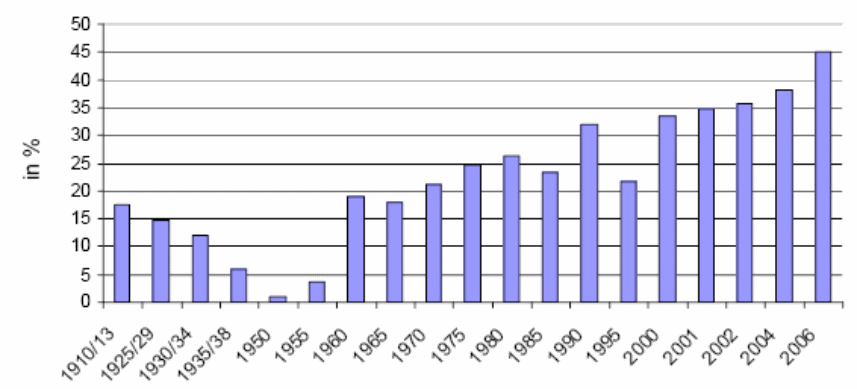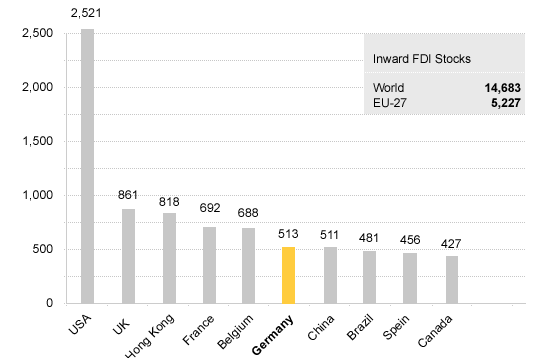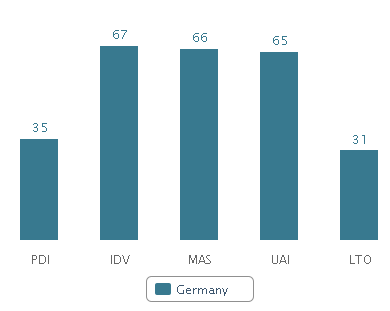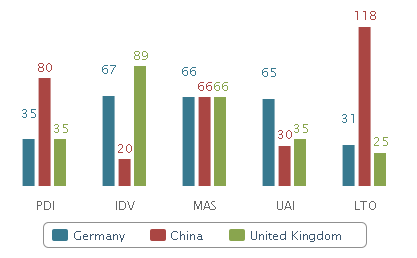Introduction
This report will assess the external and internal business environment of Germany to identify and explain the current drivers affecting SMEs; to do so, this paper will consider globalization, internal political, economic, social, and technological drivers, gross domestic product (GDP), foreign direct investment, exports from Germany and so on.
Demographic Overview
According to the report of Indexmundi (2013), the total population of this country was about 81,305,856 in 2012, the death rate was more than 1.104% and the Birth rate was 0.83%; however, the following table will provide more information about the demography of this country–
Table 1: Population pyramid dynamics for the year 2012. Source: Self-generated.
Political Factors of German
CIA (2012) argued that the Federal Republic of Germany is the second-largest nation of Europe situated in Central Europe bordering with Netherlands, Poland, and Denmark, Baltic Sea with sixteen administrative divisions; historically, the country is known as the German Empire, German Reich, and the German Republic and attained its independence on 18 January 1871. German is the largest economic power in Europe, which engrossed with two distressing World Wars and occupied by the triumphant allied forces that ultimately resulted in the division of the country into two parts in 1945 with two different political ideologies, one is FRG (Federal Republic of Germany) with a capitalist political economy, and the other is GDR (German Democratic Republic) with the economics of socialist ideology.
During the cold war era, the FRG was a part of NATO for economic and strategic security while GDR aligned with the Warsaw Pact backed by USSR; at the declining temperament of the communist rule in the world in 1990, both German decided to establish unification of them, in 1999 unified Germany aligned with the EU with a common currency.
WEF (2009) added that political stability is a major indicator for socioeconomic progress and business entry for which the position of German is at 7th in the global ranking and it scored exceptionally for social stability, infrastructural development, market growth, the flexibility of wage and strength of banking sector that delivered Germany with highly sophisticated businesses environment to attract new entries. At the same time, the wave of globalization fortunate the business communities of German to keep their increasing influence in the global economy especially in the Asian emerging market, as a major voice of the EU German has the capabilities to support sustainable international trade with minimum risk through its foreign economic and management strategies (FES 2007).
Economic Factors
Indexmundi (2013) reported that Germany is the fifth-largest economy in the globe considering purchasing power parity and greatest exporter of machinery, vehicles, and chemicals; however, the economic structure has affected to consider long-term growth due to several social problems, such as low fertility rates, failing net immigration, and other social crisis. However, Indexmundi (2013) and the Library of Congress (2008, p.9) stated that the central bank of Germany gained a marvelous reputation in the global banking history for its strong and dynamic fiscal and monetary policy to successfully stabilize the domestic economy by safeguarding the investors while the global financial system faced serious disorders.
The Impact of Globalization
Völz (2009) stated that the concept of globalization has liberalized the markets, which helped the nation to gain the capacity to boost wealth by removing trade barriers to the liberalization of the service sectors and integrating more markets all over the world. However, key features of globalization in Germany are –
- According to the report of Völz (2009, p.1), German captured share in global trade averaged 9.7% for goods, and 7.5% for services from 2000 to 2005; in addition, the earning from exports increased dramatically and it was reported for 45% of economic output;

- Globalization has increased global competition between organizations, which affected investment, growth, and employment; however, outflows of the foreign direct investment decreased by 9% from 1993 to 2005 as a consequence of globalization;
- On the other hand, local investors get the opportunity to invest more in the foreign market by using facilities of globalization;
- In addition, it intensified the division of labor and opened a new door to develop agricultural and industrial sectors;
- Overall profit margin has decreased as the competition increased significantly, for example, the following figure gives more information in this regard –

Exports from Germany (2008 to 2012)
Simoes (2012) stated that manufacturing sectors have flourished the economy of German, for instance, mineral products, transportation, chemicals, and allied industries, machinery, and other electrical products are important segments –
Table 2: Total exports from 2010 to 2012. Source: Self-generated from Simoes (2012) and Indexmundi (2013).
According to the report of Simoes (2012), France, China, the United Kingdom, the United States have played a crucial role in the export segment, so, the following tables show more data in this regard –
Table 3: – The main export collaborates of Germany. Source: – Self-generated from Simoes (2012).
Imports (2007 to 2011)
Simoes (2012) argued that most common import items are mineral products, transportation, chemicals, and allied industries, electronic integrated circuits, machinery, and parts; however, the next table will provide more information about total costs for imports of goods –
Table 4: – Total Imports from 2007 to 2012. Source: – Self-generated from Simoes (2012) and Indexmundi (2013).
Other import items include Automatic data processing machines, Aircraft, spacecraft & launch vehicles, Petroleum oils, crude, Printers and copying machines, Human or animal blood prepared for therapeutic uses, and so on.
Table 5: – The main Import collaborates of Germany. Source: – Self-generated from Simoes (2012).
Trade Balance (2008 to 2010)
Table 6: Trade balance from 2008 to 2010. Source: Self-generated.
Gross Domestic Product (GDP)
Table 7: – Gross Domestic Product (GDP) from 2008 to 2012. Source: – collected from Indexmundi (2013).
Foreign Direct Investment
UNCTAD (2012) reported that Germany ranks sixth in the globe as a recipient of FDI; however, both FDI inflows and outflows have decreased due to the global financial crisis, but the sector-wise distribution of FDI illustrates that manufacturing and the financial & insurance services sector attracts the highest volume of foreign investors. However, OECD (2011) illustrated that beside FDI inflow, Germany has a significant amount of FDI outflow where the country is highly interested to direct investment in different counties, the FDI outflow data of 2009 evidenced that the country has invested 37.63 in different countries in the corporate level that jumped at 46.14 billion in December 2010.

As per regional FDI outflow illustrates that Singapore is most fond of investing in the European countries and some Asian countries like China, and Malaysia, other counties; however, Germany’s FDI inflow and outflow have presented in the following graph –
Table 8: – Foreign Direct Investment from 2008 to 2010. Source: – OECD (2011, p.1).
Social and Cultural Drivers
According to Gordeeva (2012), the country possesses thirty million Protestants, over twenty- eight million Roman Catholics, two and a half million Muslims, and thirty- four thousand Jews in its society; with ninety- nine percent literacy-rate above the age of 15, education is obligatory in German-society until 18; moreover, 90% people have insurance coverage against sickness, accidents, long-term-care, and retirement.
Extremely deprived people in the society have state-funded coverage as well as welfare programs; in addition, the overall quality of healthcare facilities is largely admirable; moreover, secure retirement funds are given in conformity with lifetime wages and other indexes to match with living-cost fluctuations; on the other hand, range of societal well-being assistance is controlled by governmental /non-governmental organizations. It is notable that for high literacy rate, the SMEs in the country has advantages of sufficiently skilled employees, whereas numerous government-funded benefits for the citizens mean that there are no inadequacies in the society when it comes to buyers of the products and services.
Hofstede’s Country Characteristics
Power distance
Hofstede (2012) argued that less powerful members in the society anticipate and acknowledge unequal power; however, the score of power distance of Germany is only 35, which demonstrates the people of this country enjoy decentralized power with equal rights, freedom of expression for every aspect, strong leadership, and participative communication and meeting style.
Individualism/Collectivism
According to the report of Hofstede (2012), it is a basic measurement tool to address the independence level of the people; at this point, Germany scores 67, which indicates this country is truly individualistic one where people believe in the ideal of self-actualization, consider personal preferences to serve any duty for the nation and they would like small family;
Masculine / Feminine
A high score (masculine) indicates that the country will be motivated by competition, accomplishment, and success; however, German scores of 66 means it possesses a masculine society where people are self-esteem, but perform with high value;
Uncertainty Avoidance Index
German philosophy developed from Kant, Hegel, and Fichte who preferred deductive rather than inductive approaches to take a decision and design legal framework; however, German scores 65 in this dimension, which indicates that the people of this country have a preference to compensate for their greater uncertainty by robustly relying on expertise;
Long-Term Orientation
The score of German in this dimension is 31, which exhibits that the policy-makers concentrate on the short-term orientation culture respecting traditional views and the people have a small propensity to save, eager to achieve quick results, work to establish the truth like the countries of the Middle East; however, this scenario is totally different from China.


Technological Drivers
Weihrich (1999) has noted that there are certain technological drivers that have contributed to the superiority of certain German industries in the world; the country’s devotion towards international technological prominence is noted by its comparatively huge expenditure in research and development sectors than that of other nations – surprisingly, one-third of the country’s SMEs engage in research and development.
Germany is engaged with profound mechanical practices in every sector mainly because of its edifying structure; its technological strengths are also enforced because of the shortage of closely obtainable raw materials, which in turn has forced businesses to generate materials unnaturally, motivating and endorsing the social, economic, and political indexes of the country and in remaining successful in chemical-industry. Because of being the superpower in the technological arena, the country is not only leading in its automotive industry, but several other industries that boost the small and medium-size companies are also blessed with this advantage.
Environmental Drivers
According to NationMaster (2013), Germany is an average performer in terms of ensuring ecological safety; however, the country’s carbon discharge levels are quite alarming, although the government has taken necessary steps to reduce environmental footprints:
Table 9: Environmental Indicators of Germany. Source: NationMaster (2013).
Legal Factors
According to the report of Library of Congress (2008, p.19), the legal framework of this nation derived from the Roman law where courts consider a comprehensive system of legal codes instead of binding precedents; in addition, the constitution is the prime source of the legal system, but the provisions of the European Union also play a vital role as a member state of this organization. Moreover, there are special provisions under the legal system for the issues related to public funding, taxation policy, determination of taxable income, the annual depreciation rates of certain assets, additions to and deductions from taxable income, taxation of non-resident individuals, customs duty to import from non-EU member states, remuneration paid to shareholders, corporate income tax and so on (PKF 2010).
However, Kennaway (2011) stated that it is comparatively difficult for the SMEs to start a business or carry on with existing establishment though the legal system has designed with flexible provisions and not included any discriminatory provisions; the owners of foreign companies may face several problems, for instance, language barriers create hindrance in the entire management system. Library of Congress (2008) stated that the government has not set a legal minimum wage for the employees (except the employees of the construction segment); however, the employers are now bound to provide wages from €6.58 to €12.85/h to avoid legal steps against them for violation of obligations through this range varies between the Western and the Eastern parts of Germany.
Reference List
CIA 2012, The World Fact Book: Germany. Web.
FES 2007, Controlling the Risks of a Global Economy Germany’s Role. Web.
Gordeeva, T 2012, German Society. Web.
Hofstede 2012, Hofstede’s Country Characteristics – Comparison between Lebanon and Canada. Web.
Index Mundi 2013, Country Profile of Germany. Web.
Kennaway, J 2011, Starting a business in Germany. Web.
Library of Congress 2008, Country Profile Germany. Web.
NationMaster, 2013, Germany – Environment. Web.
OECD 2011, Country statistical profile: Germany 2011-2012. Web.
PKF 2010, Doing business in Germany. Web.
Simoes, A 2012, The Observatory of Economic complexity. Web.
UNCTAD 2012, FDI Data of Germany. Web.
Völz, H 2009, Globalization and the German Economy. Web.
WEF 2009, The Global Competitiveness Report 2009-2010: Country Profile Highlights. Web.
Weihrich, H 1999, Analyzing the Competitive Advantages and Disadvantages of Germany with the Tows Matrix – An Alternative To Porter’s Model. Web.